EX-99.1
Published on November 1, 2022
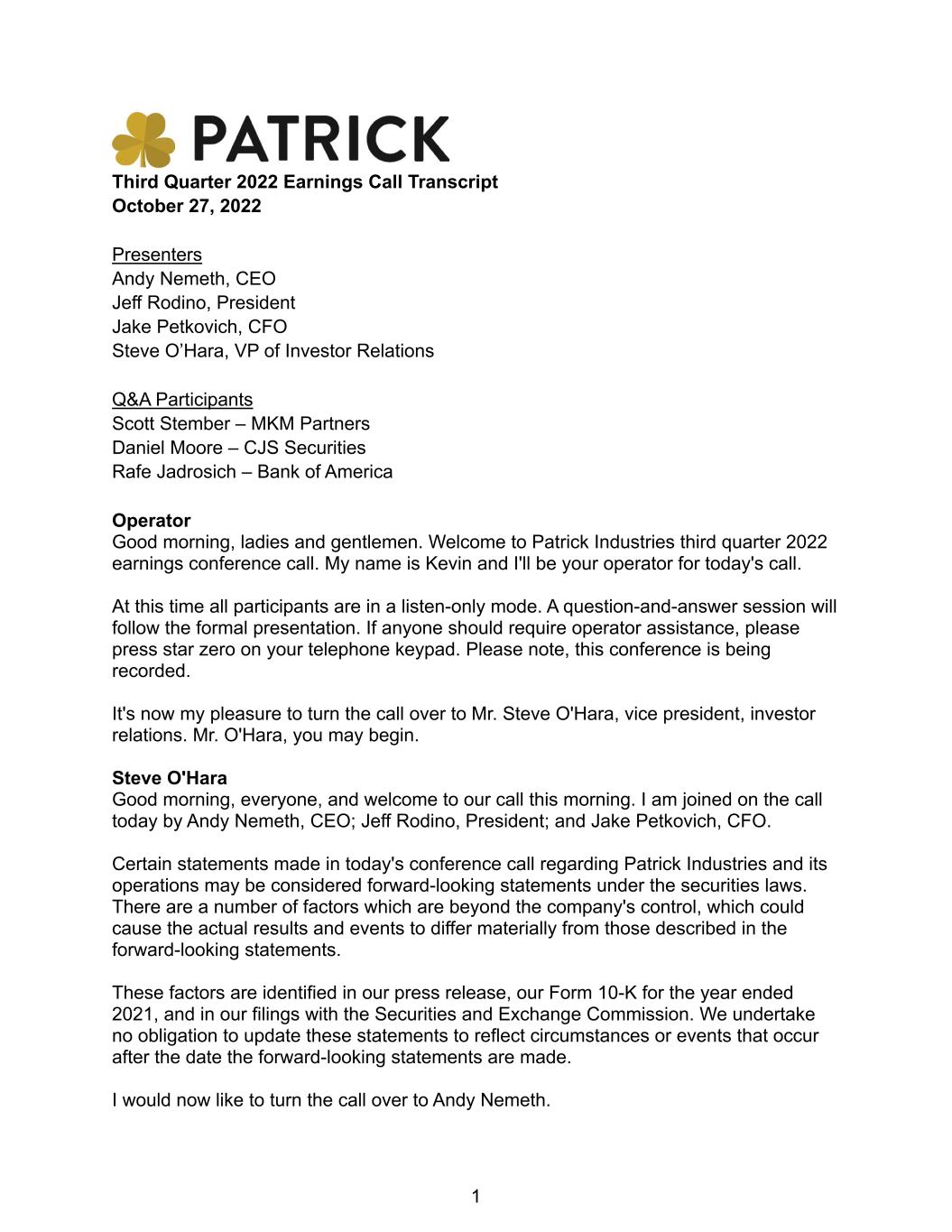
1 Third Quarter 2022 Earnings Call Transcript October 27, 2022 Presenters Andy Nemeth, CEO Jeff Rodino, President Jake Petkovich, CFO Steve O’Hara, VP of Investor Relations Q&A Participants Scott Stember – MKM Partners Daniel Moore – CJS Securities Rafe Jadrosich – Bank of America Operator Good morning, ladies and gentlemen. Welcome to Patrick Industries third quarter 2022 earnings conference call. My name is Kevin and I'll be your operator for today's call. At this time all participants are in a listen-only mode. A question-and-answer session will follow the formal presentation. If anyone should require operator assistance, please press star zero on your telephone keypad. Please note, this conference is being recorded. It's now my pleasure to turn the call over to Mr. Steve O'Hara, vice president, investor relations. Mr. O'Hara, you may begin. Steve O'Hara Good morning, everyone, and welcome to our call this morning. I am joined on the call today by Andy Nemeth, CEO; Jeff Rodino, President; and Jake Petkovich, CFO. Certain statements made in today's conference call regarding Patrick Industries and its operations may be considered forward-looking statements under the securities laws. There are a number of factors which are beyond the company's control, which could cause the actual results and events to differ materially from those described in the forward-looking statements. These factors are identified in our press release, our Form 10-K for the year ended 2021, and in our filings with the Securities and Exchange Commission. We undertake no obligation to update these statements to reflect circumstances or events that occur after the date the forward-looking statements are made. I would now like to turn the call over to Andy Nemeth.
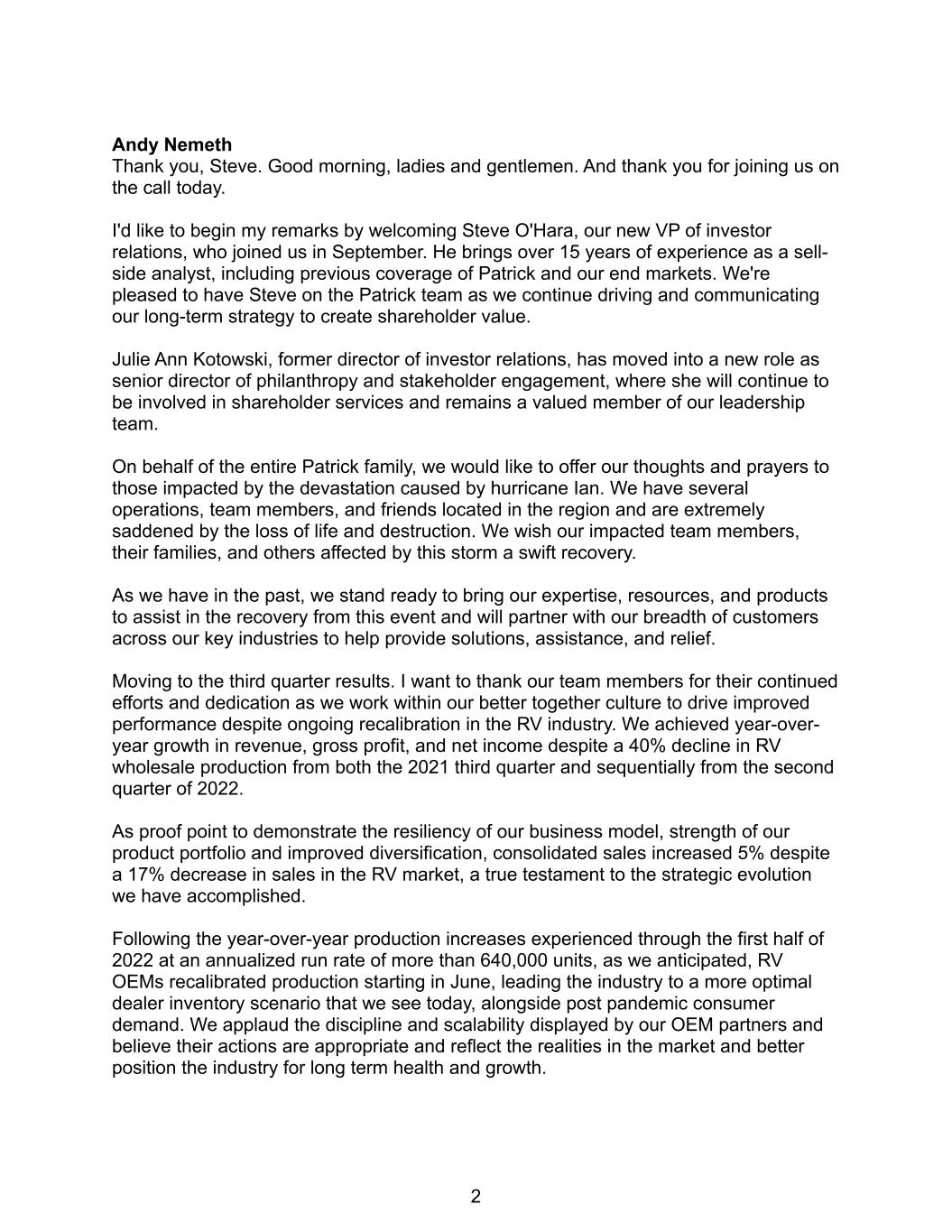
2 Andy Nemeth Thank you, Steve. Good morning, ladies and gentlemen. And thank you for joining us on the call today. I'd like to begin my remarks by welcoming Steve O'Hara, our new VP of investor relations, who joined us in September. He brings over 15 years of experience as a sell- side analyst, including previous coverage of Patrick and our end markets. We're pleased to have Steve on the Patrick team as we continue driving and communicating our long-term strategy to create shareholder value. Julie Ann Kotowski, former director of investor relations, has moved into a new role as senior director of philanthropy and stakeholder engagement, where she will continue to be involved in shareholder services and remains a valued member of our leadership team. On behalf of the entire Patrick family, we would like to offer our thoughts and prayers to those impacted by the devastation caused by hurricane Ian. We have several operations, team members, and friends located in the region and are extremely saddened by the loss of life and destruction. We wish our impacted team members, their families, and others affected by this storm a swift recovery. As we have in the past, we stand ready to bring our expertise, resources, and products to assist in the recovery from this event and will partner with our breadth of customers across our key industries to help provide solutions, assistance, and relief. Moving to the third quarter results. I want to thank our team members for their continued efforts and dedication as we work within our better together culture to drive improved performance despite ongoing recalibration in the RV industry. We achieved year-over- year growth in revenue, gross profit, and net income despite a 40% decline in RV wholesale production from both the 2021 third quarter and sequentially from the second quarter of 2022. As proof point to demonstrate the resiliency of our business model, strength of our product portfolio and improved diversification, consolidated sales increased 5% despite a 17% decrease in sales in the RV market, a true testament to the strategic evolution we have accomplished. Following the year-over-year production increases experienced through the first half of 2022 at an annualized run rate of more than 640,000 units, as we anticipated, RV OEMs recalibrated production starting in June, leading the industry to a more optimal dealer inventory scenario that we see today, alongside post pandemic consumer demand. We applaud the discipline and scalability displayed by our OEM partners and believe their actions are appropriate and reflect the realities in the market and better position the industry for long term health and growth.
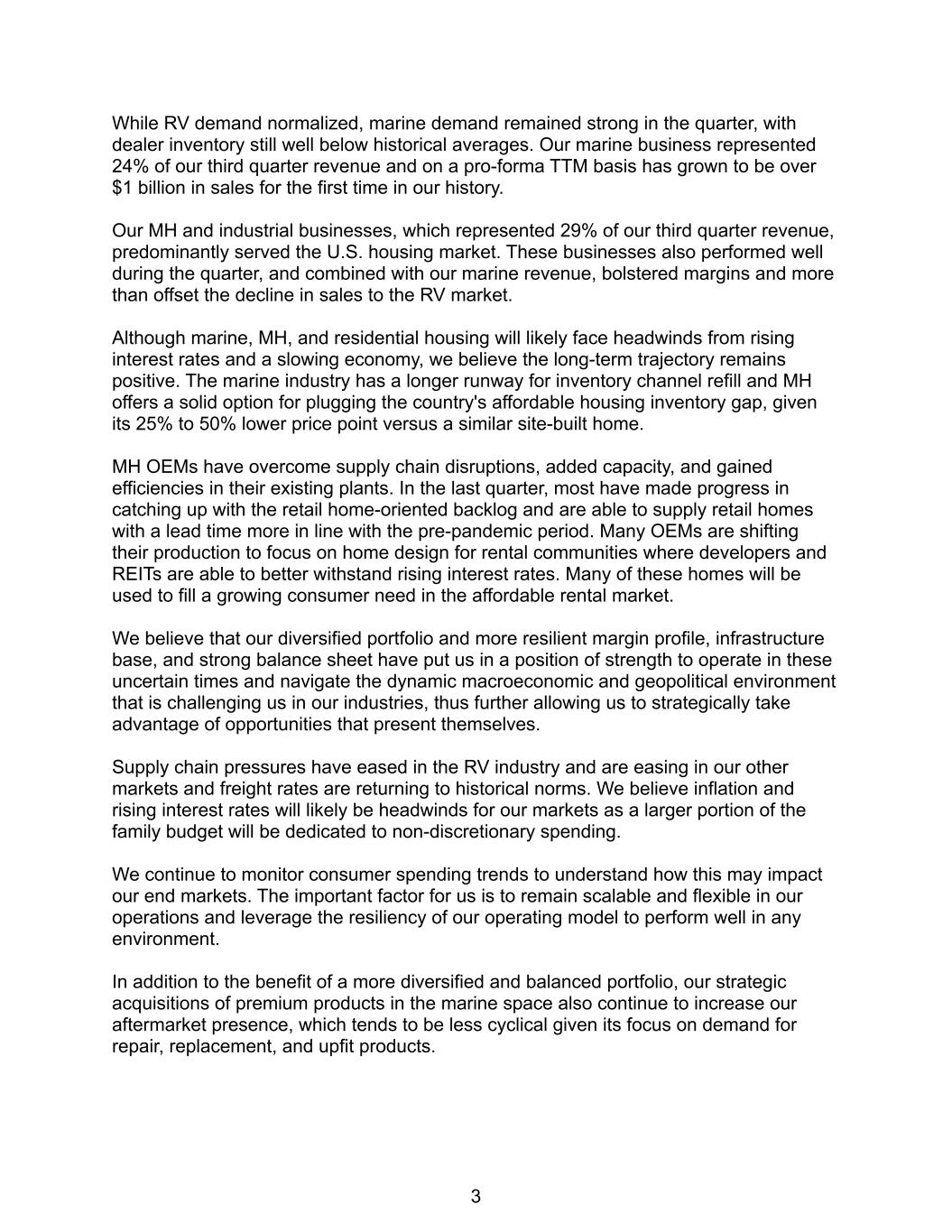
3 While RV demand normalized, marine demand remained strong in the quarter, with dealer inventory still well below historical averages. Our marine business represented 24% of our third quarter revenue and on a pro-forma TTM basis has grown to be over $1 billion in sales for the first time in our history. Our MH and industrial businesses, which represented 29% of our third quarter revenue, predominantly served the U.S. housing market. These businesses also performed well during the quarter, and combined with our marine revenue, bolstered margins and more than offset the decline in sales to the RV market. Although marine, MH, and residential housing will likely face headwinds from rising interest rates and a slowing economy, we believe the long-term trajectory remains positive. The marine industry has a longer runway for inventory channel refill and MH offers a solid option for plugging the country's affordable housing inventory gap, given its 25% to 50% lower price point versus a similar site-built home. MH OEMs have overcome supply chain disruptions, added capacity, and gained efficiencies in their existing plants. In the last quarter, most have made progress in catching up with the retail home-oriented backlog and are able to supply retail homes with a lead time more in line with the pre-pandemic period. Many OEMs are shifting their production to focus on home design for rental communities where developers and REITs are able to better withstand rising interest rates. Many of these homes will be used to fill a growing consumer need in the affordable rental market. We believe that our diversified portfolio and more resilient margin profile, infrastructure base, and strong balance sheet have put us in a position of strength to operate in these uncertain times and navigate the dynamic macroeconomic and geopolitical environment that is challenging us in our industries, thus further allowing us to strategically take advantage of opportunities that present themselves. Supply chain pressures have eased in the RV industry and are easing in our other markets and freight rates are returning to historical norms. We believe inflation and rising interest rates will likely be headwinds for our markets as a larger portion of the family budget will be dedicated to non-discretionary spending. We continue to monitor consumer spending trends to understand how this may impact our end markets. The important factor for us is to remain scalable and flexible in our operations and leverage the resiliency of our operating model to perform well in any environment. In addition to the benefit of a more diversified and balanced portfolio, our strategic acquisitions of premium products in the marine space also continue to increase our aftermarket presence, which tends to be less cyclical given its focus on demand for repair, replacement, and upfit products.
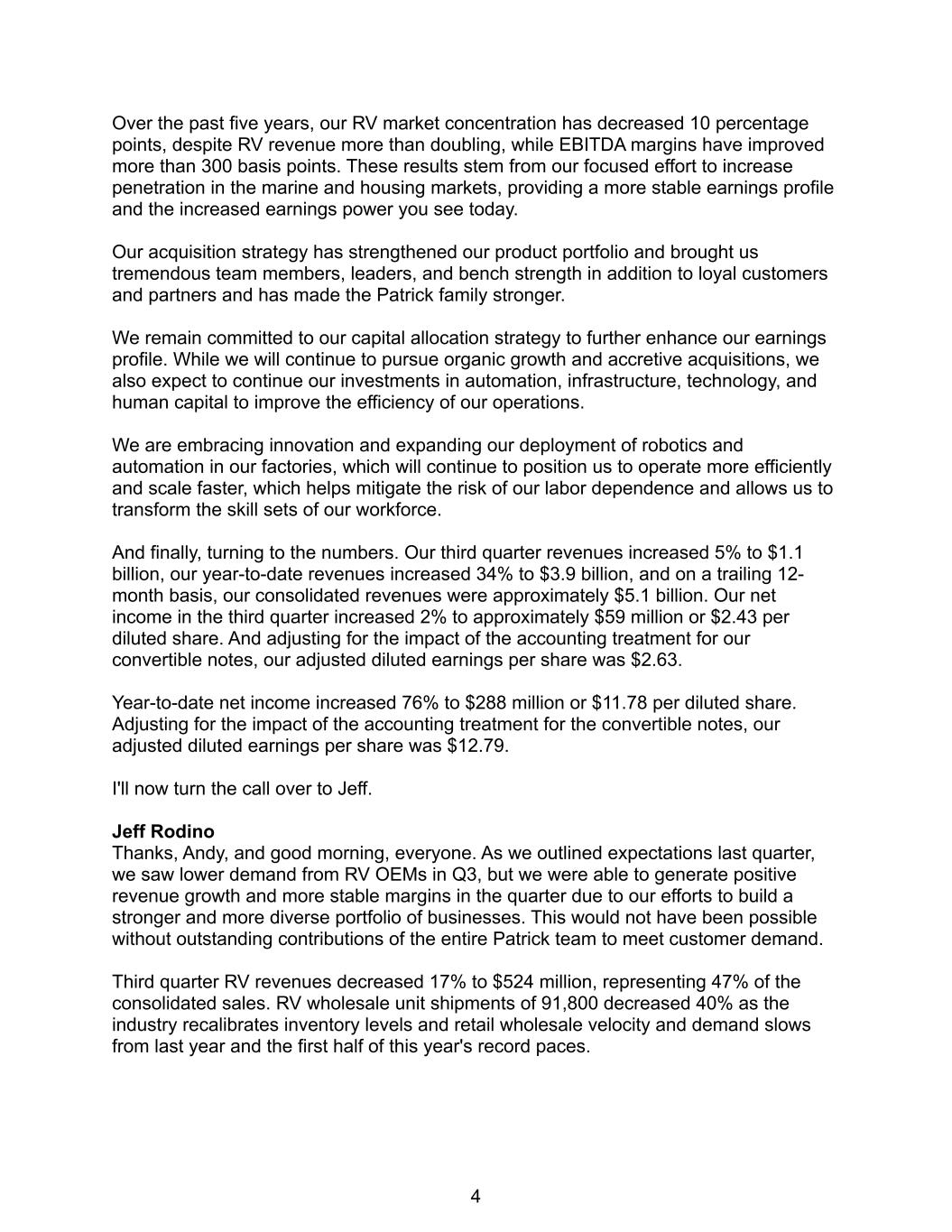
4 Over the past five years, our RV market concentration has decreased 10 percentage points, despite RV revenue more than doubling, while EBITDA margins have improved more than 300 basis points. These results stem from our focused effort to increase penetration in the marine and housing markets, providing a more stable earnings profile and the increased earnings power you see today. Our acquisition strategy has strengthened our product portfolio and brought us tremendous team members, leaders, and bench strength in addition to loyal customers and partners and has made the Patrick family stronger. We remain committed to our capital allocation strategy to further enhance our earnings profile. While we will continue to pursue organic growth and accretive acquisitions, we also expect to continue our investments in automation, infrastructure, technology, and human capital to improve the efficiency of our operations. We are embracing innovation and expanding our deployment of robotics and automation in our factories, which will continue to position us to operate more efficiently and scale faster, which helps mitigate the risk of our labor dependence and allows us to transform the skill sets of our workforce. And finally, turning to the numbers. Our third quarter revenues increased 5% to $1.1 billion, our year-to-date revenues increased 34% to $3.9 billion, and on a trailing 12- month basis, our consolidated revenues were approximately $5.1 billion. Our net income in the third quarter increased 2% to approximately $59 million or $2.43 per diluted share. And adjusting for the impact of the accounting treatment for our convertible notes, our adjusted diluted earnings per share was $2.63. Year-to-date net income increased 76% to $288 million or $11.78 per diluted share. Adjusting for the impact of the accounting treatment for the convertible notes, our adjusted diluted earnings per share was $12.79. I'll now turn the call over to Jeff. Jeff Rodino Thanks, Andy, and good morning, everyone. As we outlined expectations last quarter, we saw lower demand from RV OEMs in Q3, but we were able to generate positive revenue growth and more stable margins in the quarter due to our efforts to build a stronger and more diverse portfolio of businesses. This would not have been possible without outstanding contributions of the entire Patrick team to meet customer demand. Third quarter RV revenues decreased 17% to $524 million, representing 47% of the consolidated sales. RV wholesale unit shipments of 91,800 decreased 40% as the industry recalibrates inventory levels and retail wholesale velocity and demand slows from last year and the first half of this year's record paces.
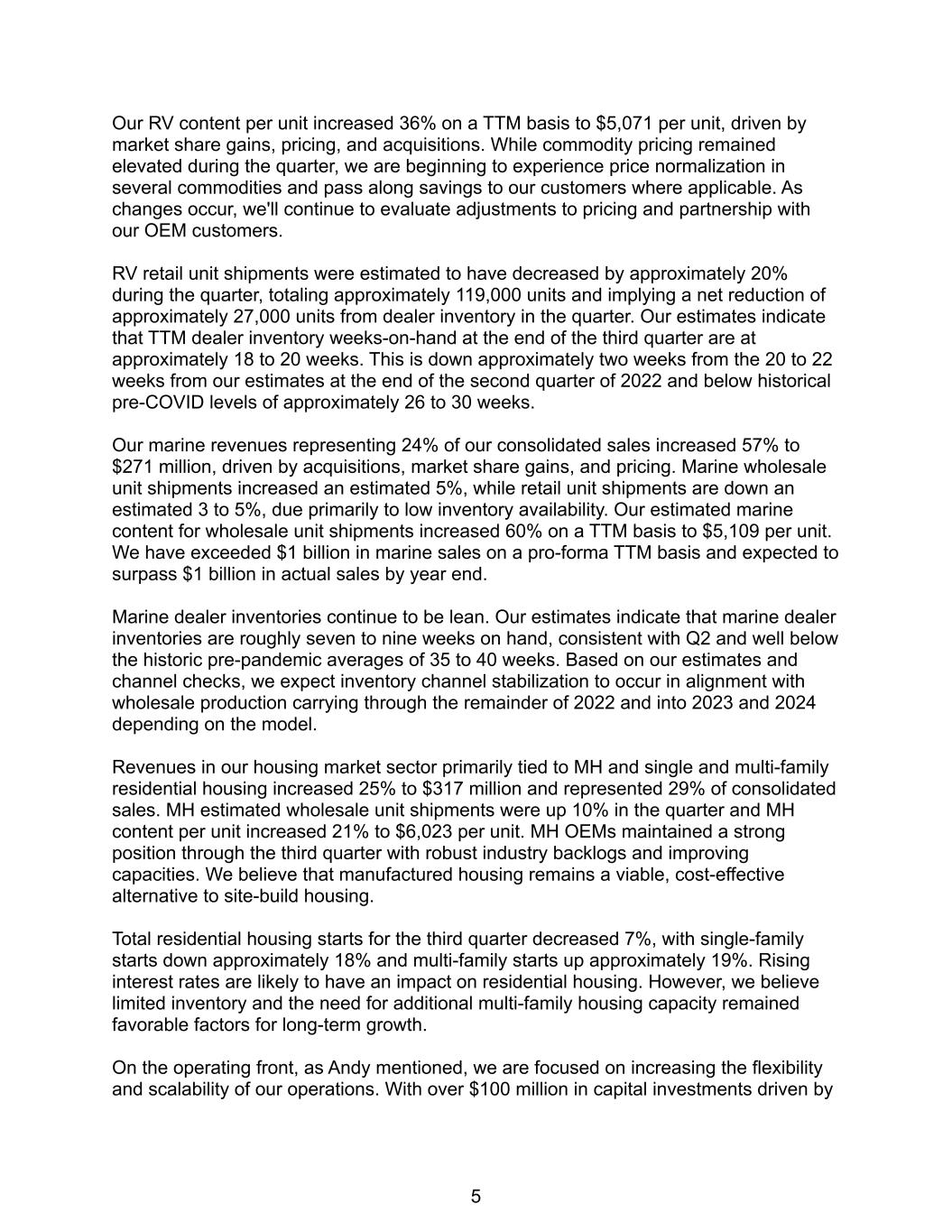
5 Our RV content per unit increased 36% on a TTM basis to $5,071 per unit, driven by market share gains, pricing, and acquisitions. While commodity pricing remained elevated during the quarter, we are beginning to experience price normalization in several commodities and pass along savings to our customers where applicable. As changes occur, we'll continue to evaluate adjustments to pricing and partnership with our OEM customers. RV retail unit shipments were estimated to have decreased by approximately 20% during the quarter, totaling approximately 119,000 units and implying a net reduction of approximately 27,000 units from dealer inventory in the quarter. Our estimates indicate that TTM dealer inventory weeks-on-hand at the end of the third quarter are at approximately 18 to 20 weeks. This is down approximately two weeks from the 20 to 22 weeks from our estimates at the end of the second quarter of 2022 and below historical pre-COVID levels of approximately 26 to 30 weeks. Our marine revenues representing 24% of our consolidated sales increased 57% to $271 million, driven by acquisitions, market share gains, and pricing. Marine wholesale unit shipments increased an estimated 5%, while retail unit shipments are down an estimated 3 to 5%, due primarily to low inventory availability. Our estimated marine content for wholesale unit shipments increased 60% on a TTM basis to $5,109 per unit. We have exceeded $1 billion in marine sales on a pro-forma TTM basis and expected to surpass $1 billion in actual sales by year end. Marine dealer inventories continue to be lean. Our estimates indicate that marine dealer inventories are roughly seven to nine weeks on hand, consistent with Q2 and well below the historic pre-pandemic averages of 35 to 40 weeks. Based on our estimates and channel checks, we expect inventory channel stabilization to occur in alignment with wholesale production carrying through the remainder of 2022 and into 2023 and 2024 depending on the model. Revenues in our housing market sector primarily tied to MH and single and multi-family residential housing increased 25% to $317 million and represented 29% of consolidated sales. MH estimated wholesale unit shipments were up 10% in the quarter and MH content per unit increased 21% to $6,023 per unit. MH OEMs maintained a strong position through the third quarter with robust industry backlogs and improving capacities. We believe that manufactured housing remains a viable, cost-effective alternative to site-build housing. Total residential housing starts for the third quarter decreased 7%, with single-family starts down approximately 18% and multi-family starts up approximately 19%. Rising interest rates are likely to have an impact on residential housing. However, we believe limited inventory and the need for additional multi-family housing capacity remained favorable factors for long-term growth. On the operating front, as Andy mentioned, we are focused on increasing the flexibility and scalability of our operations. With over $100 million in capital investments driven by
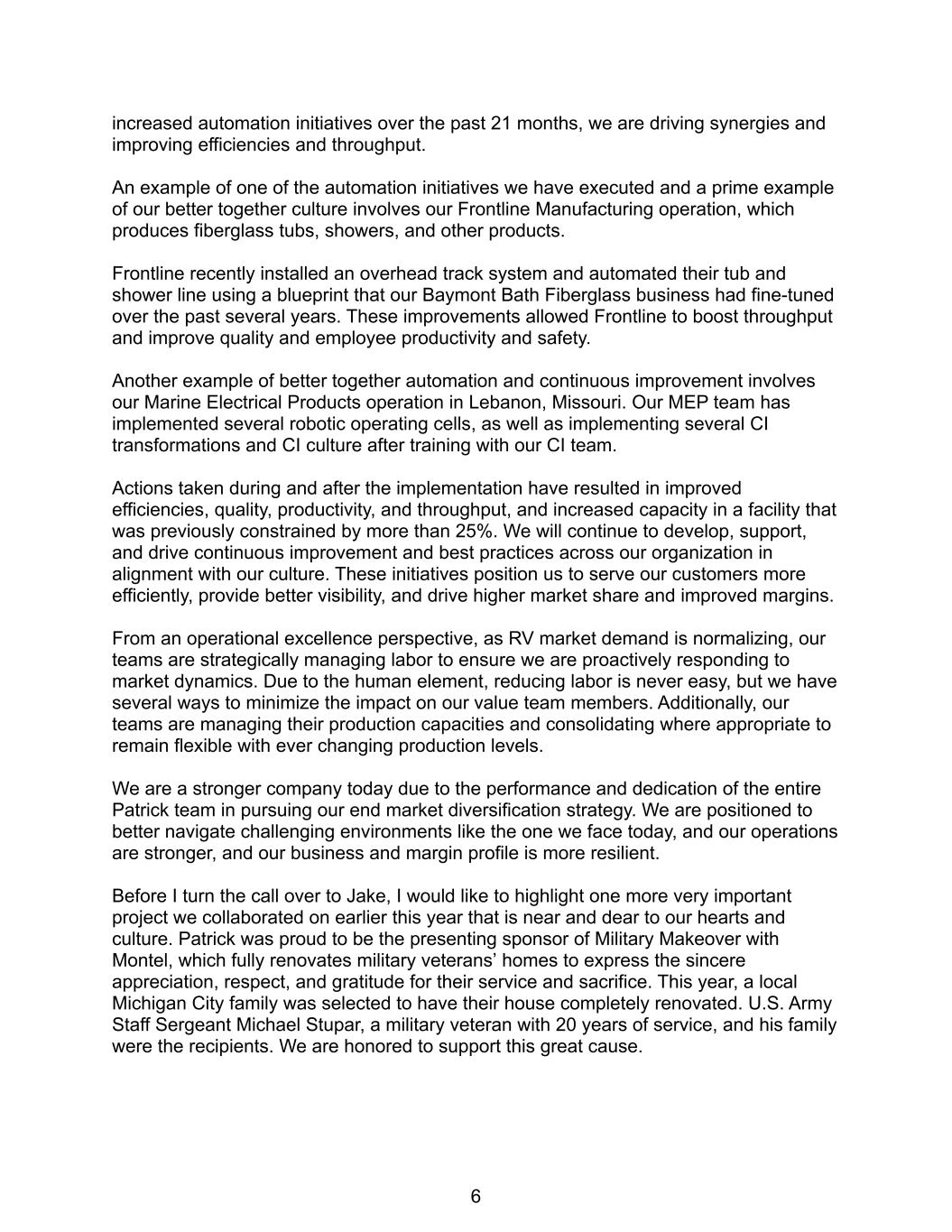
6 increased automation initiatives over the past 21 months, we are driving synergies and improving efficiencies and throughput. An example of one of the automation initiatives we have executed and a prime example of our better together culture involves our Frontline Manufacturing operation, which produces fiberglass tubs, showers, and other products. Frontline recently installed an overhead track system and automated their tub and shower line using a blueprint that our Baymont Bath Fiberglass business had fine-tuned over the past several years. These improvements allowed Frontline to boost throughput and improve quality and employee productivity and safety. Another example of better together automation and continuous improvement involves our Marine Electrical Products operation in Lebanon, Missouri. Our MEP team has implemented several robotic operating cells, as well as implementing several CI transformations and CI culture after training with our CI team. Actions taken during and after the implementation have resulted in improved efficiencies, quality, productivity, and throughput, and increased capacity in a facility that was previously constrained by more than 25%. We will continue to develop, support, and drive continuous improvement and best practices across our organization in alignment with our culture. These initiatives position us to serve our customers more efficiently, provide better visibility, and drive higher market share and improved margins. From an operational excellence perspective, as RV market demand is normalizing, our teams are strategically managing labor to ensure we are proactively responding to market dynamics. Due to the human element, reducing labor is never easy, but we have several ways to minimize the impact on our value team members. Additionally, our teams are managing their production capacities and consolidating where appropriate to remain flexible with ever changing production levels. We are a stronger company today due to the performance and dedication of the entire Patrick team in pursuing our end market diversification strategy. We are positioned to better navigate challenging environments like the one we face today, and our operations are stronger, and our business and margin profile is more resilient. Before I turn the call over to Jake, I would like to highlight one more very important project we collaborated on earlier this year that is near and dear to our hearts and culture. Patrick was proud to be the presenting sponsor of Military Makeover with Montel, which fully renovates military veterans’ homes to express the sincere appreciation, respect, and gratitude for their service and sacrifice. This year, a local Michigan City family was selected to have their house completely renovated. U.S. Army Staff Sergeant Michael Stupar, a military veteran with 20 years of service, and his family were the recipients. We are honored to support this great cause.
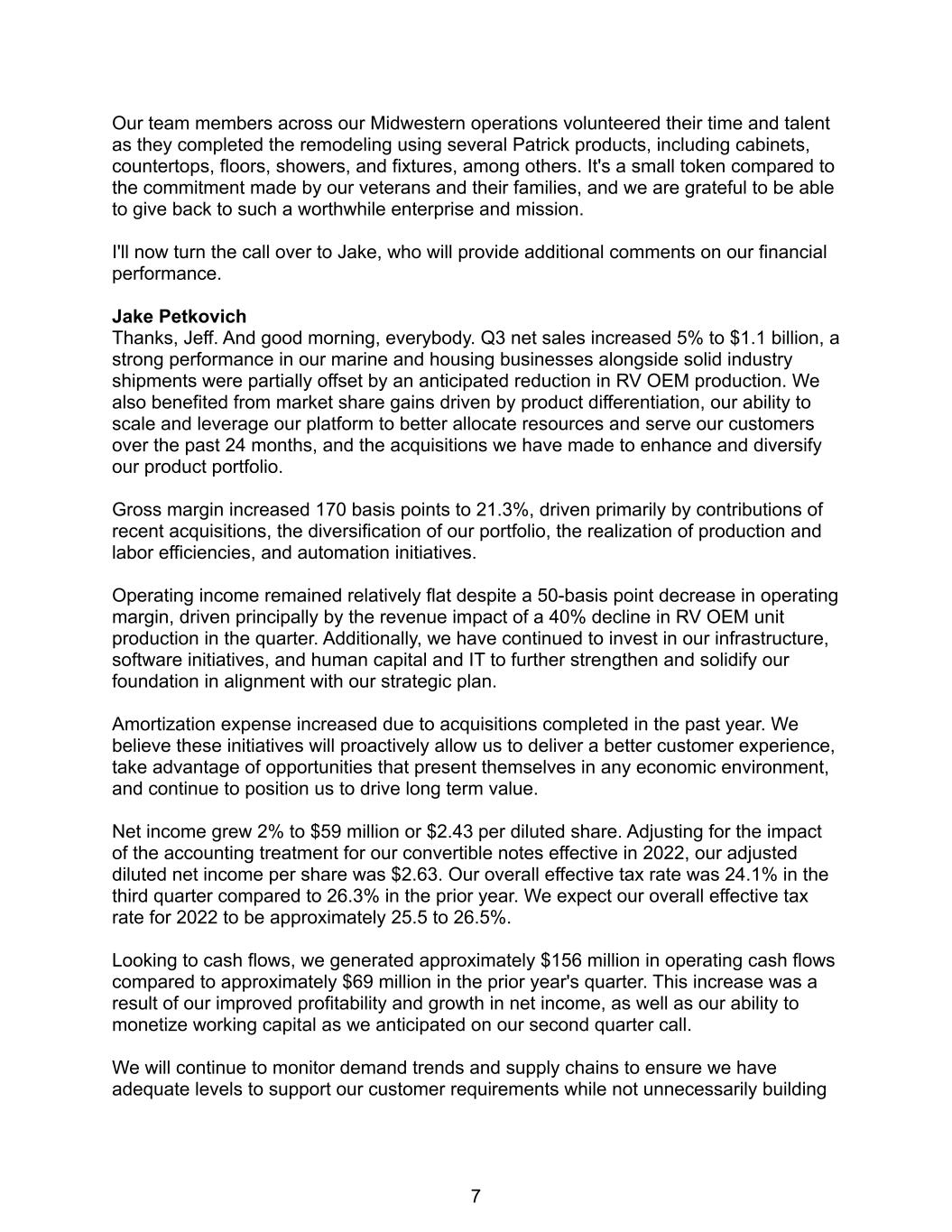
7 Our team members across our Midwestern operations volunteered their time and talent as they completed the remodeling using several Patrick products, including cabinets, countertops, floors, showers, and fixtures, among others. It's a small token compared to the commitment made by our veterans and their families, and we are grateful to be able to give back to such a worthwhile enterprise and mission. I'll now turn the call over to Jake, who will provide additional comments on our financial performance. Jake Petkovich Thanks, Jeff. And good morning, everybody. Q3 net sales increased 5% to $1.1 billion, a strong performance in our marine and housing businesses alongside solid industry shipments were partially offset by an anticipated reduction in RV OEM production. We also benefited from market share gains driven by product differentiation, our ability to scale and leverage our platform to better allocate resources and serve our customers over the past 24 months, and the acquisitions we have made to enhance and diversify our product portfolio. Gross margin increased 170 basis points to 21.3%, driven primarily by contributions of recent acquisitions, the diversification of our portfolio, the realization of production and labor efficiencies, and automation initiatives. Operating income remained relatively flat despite a 50-basis point decrease in operating margin, driven principally by the revenue impact of a 40% decline in RV OEM unit production in the quarter. Additionally, we have continued to invest in our infrastructure, software initiatives, and human capital and IT to further strengthen and solidify our foundation in alignment with our strategic plan. Amortization expense increased due to acquisitions completed in the past year. We believe these initiatives will proactively allow us to deliver a better customer experience, take advantage of opportunities that present themselves in any economic environment, and continue to position us to drive long term value. Net income grew 2% to $59 million or $2.43 per diluted share. Adjusting for the impact of the accounting treatment for our convertible notes effective in 2022, our adjusted diluted net income per share was $2.63. Our overall effective tax rate was 24.1% in the third quarter compared to 26.3% in the prior year. We expect our overall effective tax rate for 2022 to be approximately 25.5 to 26.5%. Looking to cash flows, we generated approximately $156 million in operating cash flows compared to approximately $69 million in the prior year's quarter. This increase was a result of our improved profitability and growth in net income, as well as our ability to monetize working capital as we anticipated on our second quarter call. We will continue to monitor demand trends and supply chains to ensure we have adequate levels to support our customer requirements while not unnecessarily building

8 inventory. While our inventory levels are still elevated as a result of prioritizing our customers' needs over the past 24 months during severe supply chain constraints, we are proud of the work our team has done to balance these objectives and believe we can continue to monetize our working capital for the remainder of 2022 and into 2023. This quarter, we invested $19 million in capital expenditures, centered on developing operational efficiencies through investments in automation, and technological improvements. In combination with our highly variable cost structure, we are confident that our investment in capital expenditure initiatives positions us well to face various macroeconomic environments that may materialize in the coming quarters. We still expect our full year capital expenditures to be in the $90 million range, demonstrating our steadfast dedication to the initiatives we've described. Although we did not complete any acquisitions in the third quarter, we've invested $153 million year-to-date, which has been directed towards higher value and higher engineered products and those that sell into the aftermarket. Acquisitions remain a pivotal priority in our capital deployment strategy as we continue to focus on well-run, quality businesses with a focus on growth and diversification. We repurchased approximately 154,400 shares for a total of approximately $7 million in the quarter and returned $7 million to shareholders in the form of quarterly dividends. Year-to-date, we have repurchased $47 million in shares and paid $23 million in dividends, resulting in $70 million in total cash returned to our shareholders. At the end of the third quarter, we had approximately $485 million in total net liquidity comprised of $53 million of cash-on-hand and unused capacity on our revolving credit facility of $432 million. This unused capacity on our revolving credit facility includes the impacts of a $202.5 million reserve for the settlement of our convertible notes due February 2023. In August, we expanded our credit facility to $925 million, bolstering our nimble and flexible financial position and supporting our ability to execute our business strategy. Our total net leverage ratio is 1.8 times. Our robust liquidity profile gives us the confidence to navigate the uncertain macroeconomic environment while providing flexibility to best meet our customers' needs. This profile, coupled with our ability to continue to monetize working capital, positions us to execute our disciplined capital allocation strategy. Moving to our end market outlook and starting with RV, we have seen OEMs adjust production to keep dealer inventory at healthy levels. We think these actions will be a long-term benefit for the industry. We currently estimate full year 2022 RV wholesale unit shipments to approximate 480,000 units, implying Q4 wholesale shipments of approximately 60,000 to 70,000 units. We currently expect full year retail shipments to be down approximately 20 to
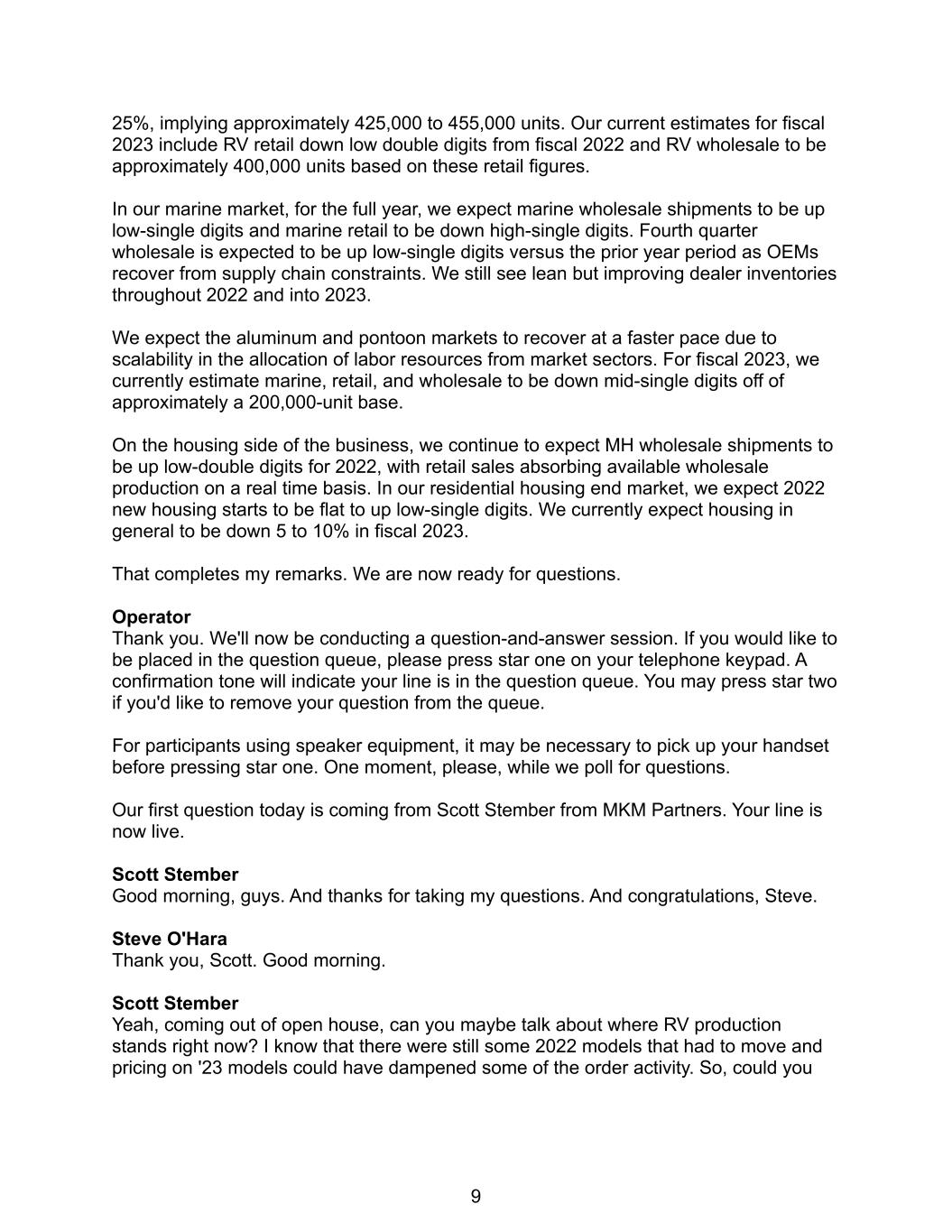
9 25%, implying approximately 425,000 to 455,000 units. Our current estimates for fiscal 2023 include RV retail down low double digits from fiscal 2022 and RV wholesale to be approximately 400,000 units based on these retail figures. In our marine market, for the full year, we expect marine wholesale shipments to be up low-single digits and marine retail to be down high-single digits. Fourth quarter wholesale is expected to be up low-single digits versus the prior year period as OEMs recover from supply chain constraints. We still see lean but improving dealer inventories throughout 2022 and into 2023. We expect the aluminum and pontoon markets to recover at a faster pace due to scalability in the allocation of labor resources from market sectors. For fiscal 2023, we currently estimate marine, retail, and wholesale to be down mid-single digits off of approximately a 200,000-unit base. On the housing side of the business, we continue to expect MH wholesale shipments to be up low-double digits for 2022, with retail sales absorbing available wholesale production on a real time basis. In our residential housing end market, we expect 2022 new housing starts to be flat to up low-single digits. We currently expect housing in general to be down 5 to 10% in fiscal 2023. That completes my remarks. We are now ready for questions. Operator Thank you. We'll now be conducting a question-and-answer session. If you would like to be placed in the question queue, please press star one on your telephone keypad. A confirmation tone will indicate your line is in the question queue. You may press star two if you'd like to remove your question from the queue. For participants using speaker equipment, it may be necessary to pick up your handset before pressing star one. One moment, please, while we poll for questions. Our first question today is coming from Scott Stember from MKM Partners. Your line is now live. Scott Stember Good morning, guys. And thanks for taking my questions. And congratulations, Steve. Steve O'Hara Thank you, Scott. Good morning. Scott Stember Yeah, coming out of open house, can you maybe talk about where RV production stands right now? I know that there were still some 2022 models that had to move and pricing on '23 models could have dampened some of the order activity. So, could you
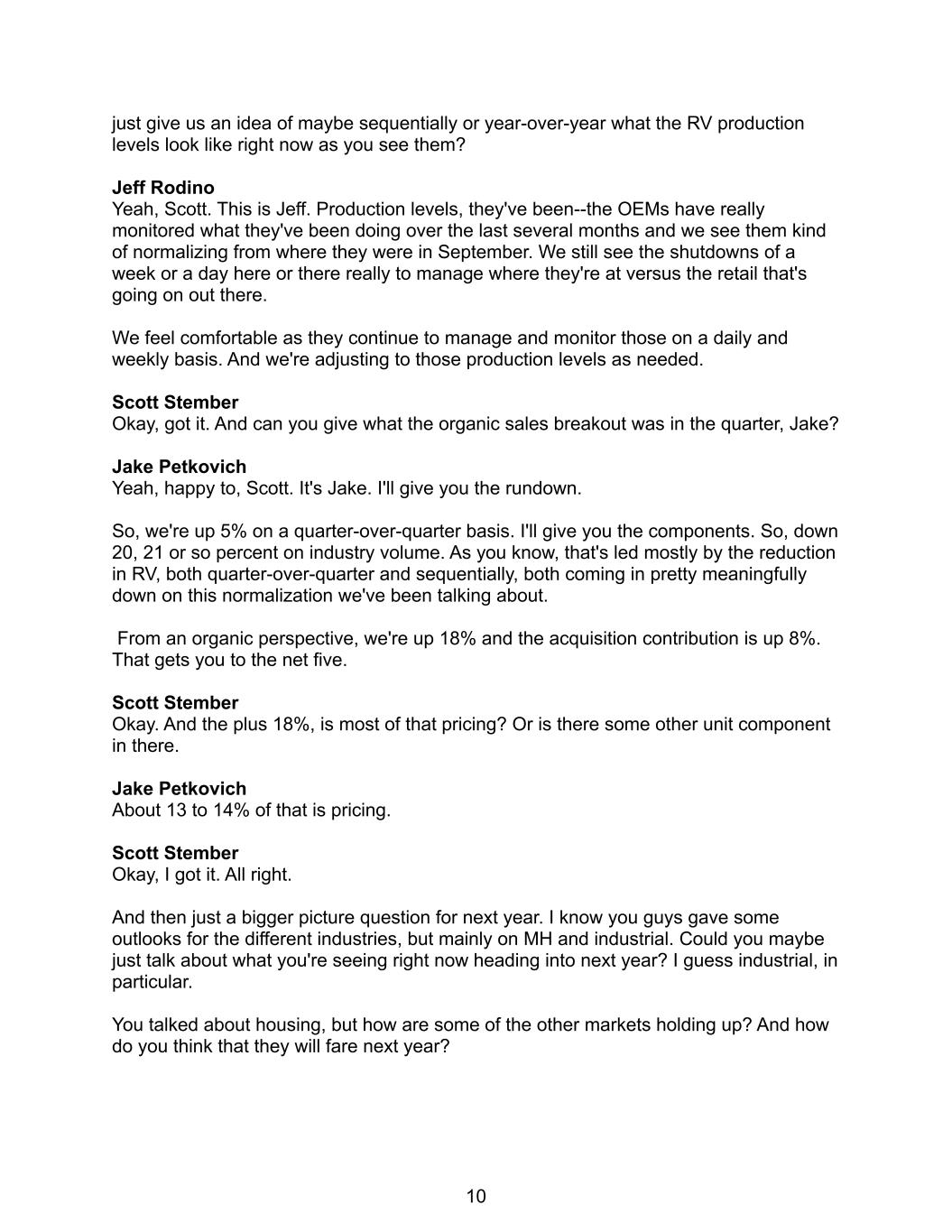
10 just give us an idea of maybe sequentially or year-over-year what the RV production levels look like right now as you see them? Jeff Rodino Yeah, Scott. This is Jeff. Production levels, they've been--the OEMs have really monitored what they've been doing over the last several months and we see them kind of normalizing from where they were in September. We still see the shutdowns of a week or a day here or there really to manage where they're at versus the retail that's going on out there. We feel comfortable as they continue to manage and monitor those on a daily and weekly basis. And we're adjusting to those production levels as needed. Scott Stember Okay, got it. And can you give what the organic sales breakout was in the quarter, Jake? Jake Petkovich Yeah, happy to, Scott. It's Jake. I'll give you the rundown. So, we're up 5% on a quarter-over-quarter basis. I'll give you the components. So, down 20, 21 or so percent on industry volume. As you know, that's led mostly by the reduction in RV, both quarter-over-quarter and sequentially, both coming in pretty meaningfully down on this normalization we've been talking about. From an organic perspective, we're up 18% and the acquisition contribution is up 8%. That gets you to the net five. Scott Stember Okay. And the plus 18%, is most of that pricing? Or is there some other unit component in there. Jake Petkovich About 13 to 14% of that is pricing. Scott Stember Okay, I got it. All right. And then just a bigger picture question for next year. I know you guys gave some outlooks for the different industries, but mainly on MH and industrial. Could you maybe just talk about what you're seeing right now heading into next year? I guess industrial, in particular. You talked about housing, but how are some of the other markets holding up? And how do you think that they will fare next year?
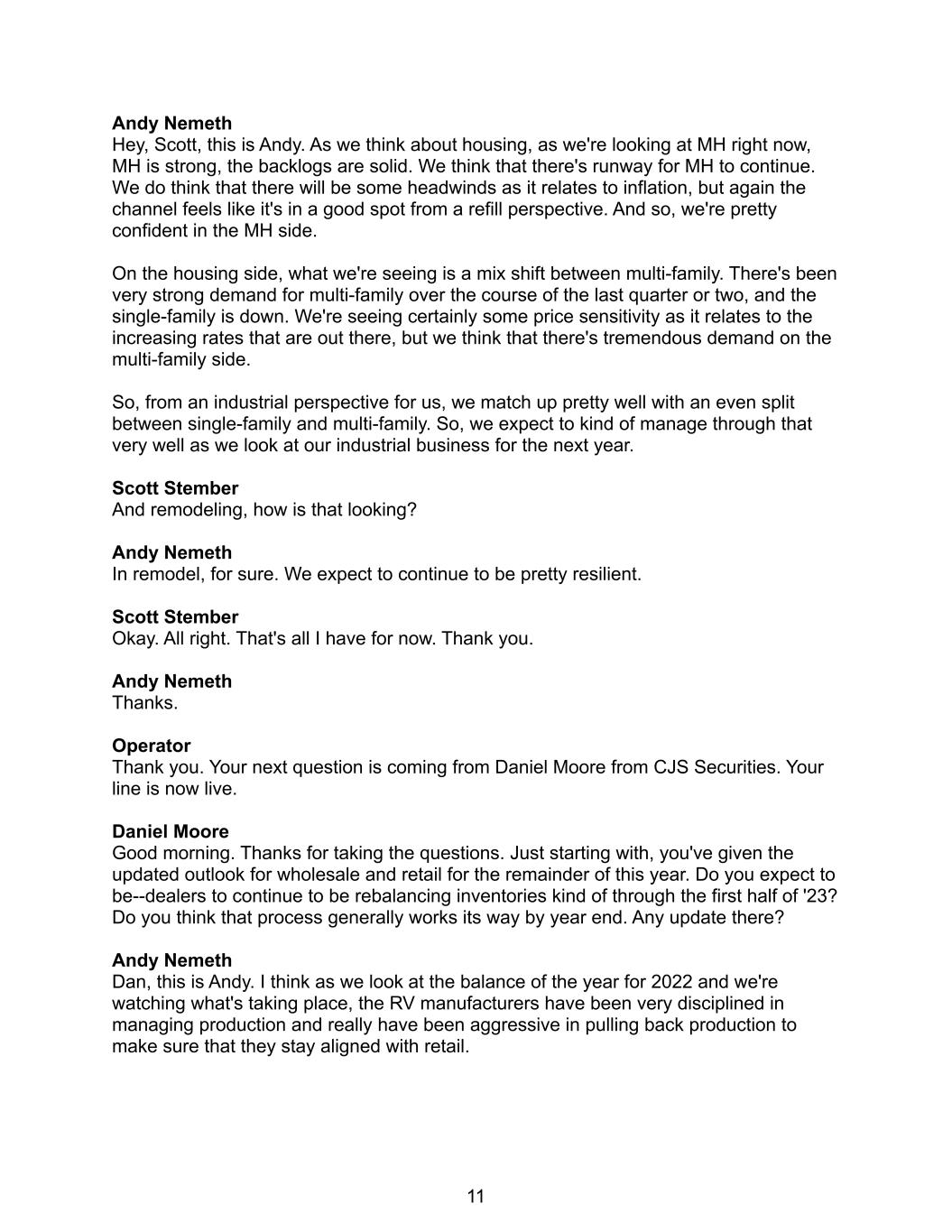
11 Andy Nemeth Hey, Scott, this is Andy. As we think about housing, as we're looking at MH right now, MH is strong, the backlogs are solid. We think that there's runway for MH to continue. We do think that there will be some headwinds as it relates to inflation, but again the channel feels like it's in a good spot from a refill perspective. And so, we're pretty confident in the MH side. On the housing side, what we're seeing is a mix shift between multi-family. There's been very strong demand for multi-family over the course of the last quarter or two, and the single-family is down. We're seeing certainly some price sensitivity as it relates to the increasing rates that are out there, but we think that there's tremendous demand on the multi-family side. So, from an industrial perspective for us, we match up pretty well with an even split between single-family and multi-family. So, we expect to kind of manage through that very well as we look at our industrial business for the next year. Scott Stember And remodeling, how is that looking? Andy Nemeth In remodel, for sure. We expect to continue to be pretty resilient. Scott Stember Okay. All right. That's all I have for now. Thank you. Andy Nemeth Thanks. Operator Thank you. Your next question is coming from Daniel Moore from CJS Securities. Your line is now live. Daniel Moore Good morning. Thanks for taking the questions. Just starting with, you've given the updated outlook for wholesale and retail for the remainder of this year. Do you expect to be--dealers to continue to be rebalancing inventories kind of through the first half of '23? Do you think that process generally works its way by year end. Any update there? Andy Nemeth Dan, this is Andy. I think as we look at the balance of the year for 2022 and we're watching what's taking place, the RV manufacturers have been very disciplined in managing production and really have been aggressive in pulling back production to make sure that they stay aligned with retail.

12 When we look at the inventory that's out there today in the channel, we absolutely believe we're at discounted levels from where it's historically run. What we see today is a mix change kind of happening out in the marketplace as it relates to dealers fine tuning their mix balance that they prefer going into next year. And so, as we look at things, we're anticipating and I think what we see, at least in our OE partners and I certainly don't want to speak for them, but what we're watching is we think that there's a rebalancing of the mix as we take place through the back part of the year with very disciplined production, pullbacks, which we think is very, very rational and then kind of positioning for a strong kind of fiscal 2023 as it relates to one-to-one retail and wholesale. So, mix shift for the balance of the rest of the year, disciplined production, and then in anticipation of kind of where 2023 rolls out as it relates to retail pull through. Daniel Moore Helpful. And just how do we think--how should we think about either gross margins and operating margins in Q4 as well as into H1 '23 relative to the quarter we just saw given some of the production level expectations? Jake Petkovich Dan, it's Jake, and I appreciate the question. Maybe to start with the full year, we still think that on a year-over-year basis, '22 versus '21, we're up operating margin, for example, 130 to 150 basis points. So, a lot of that follows the theme we've been speaking about for about 18 months here and the impact of both our investments in automation and other production efficiency initiatives which have been meaningful, and Jeff highlighted a few of those here this morning as well. But also the complexion of the acquisitions that we've made over time and their contribution as we continue to--into the higher fabrication, higher value-added products, which are really contributing as well. So with the two of those, we think about the first quarter over first quarter. Of course, production will drive a lot of that as we think about absorption and other impacts. Jeff spoke a little bit about pricing and our intent to hold that as best we can, but we still expect to be up on a quarter-over-quarter basis any way you look at it and really realize these improvements. And one thing we've spoken a lot about is, a great comparable as the folks like to point to is 2019 as kind of a normal year, pre-COVID so to speak. We think about the investments we've made in the portfolio over that time and the results that we have seen that are really resonating through those margins and what we expect to see in the future. And if you just take a couple of seconds to think about over--since beginning of 2019 through now, we've put about $1 billion into acquisitions, about $840 million of revenue has come along with those at the time of acquisition, which we've grown about 40% or so to $1.2 billion contribution from those years of acquisitions. It's really resonating in

13 the strategic diversification which speaks to the portfolio concept that we've been--that we've really benefited from this month. And it's really shown through as we've seen that 40% decline in RV, but only a net 21% down volume as I spoke about in the previous questions that came through. We think about some of the core pieces of our acquisition filters or criteria, and one of those is that margin accretion. And if you still think about that basket of acquisitions that I'm speaking to, and we think of those collectively having about a 27% gross margin profile, 13 to 15% operating margin profile. Still very accretive to what we're doing, and we expect to see that on top of these efficiencies and the capex we spent really resonate through and be buoyant to our profitability as we move forward. Daniel Moore Sorry about that. I was on mute. Thank you very much. I appreciate the color and maybe one more, and I'll jump back in queue. But just in terms of--yeah, you mentioned pricing, if you could provide a little bit more color. You'd be opportunistic or giving back some of those pricing as raw materials come back down, just as it relates to margins, let's say over the next couple of quarters. Do you expect a little bit of a benefit and a lag between commodity pricing and when you give those back? Or is it more real time? That's it for me. Thanks. Jeff Rodino Yeah, Dan, this is Jeff. We're working with our customers on a regular basis to manage the pricing as it goes down, as we see commodities go down. Really in the third quarter we did--we were able to give back some pricing. We also, in some cases, held pricing when we saw commodities continue to rise a little bit through the third quarter. So, we're being very flexible with our customers as pricing goes down the same way we were when they were with us when pricing went up. So, we see there is definitely some decline in the commodities coming down the road. And we will continue to work with customers kind of more of in a real-time basis as we see those opportunities arise. Daniel Moore Thank you, again. Operator Thank you. As a reminder, that's star one to be placed in the question queue. Our next question today is coming from Rafe Jadrosich from Bank of America. Your line is now live. Rafe Jadrosich Hi, its Rafe. Good morning. Thanks for taking my question.
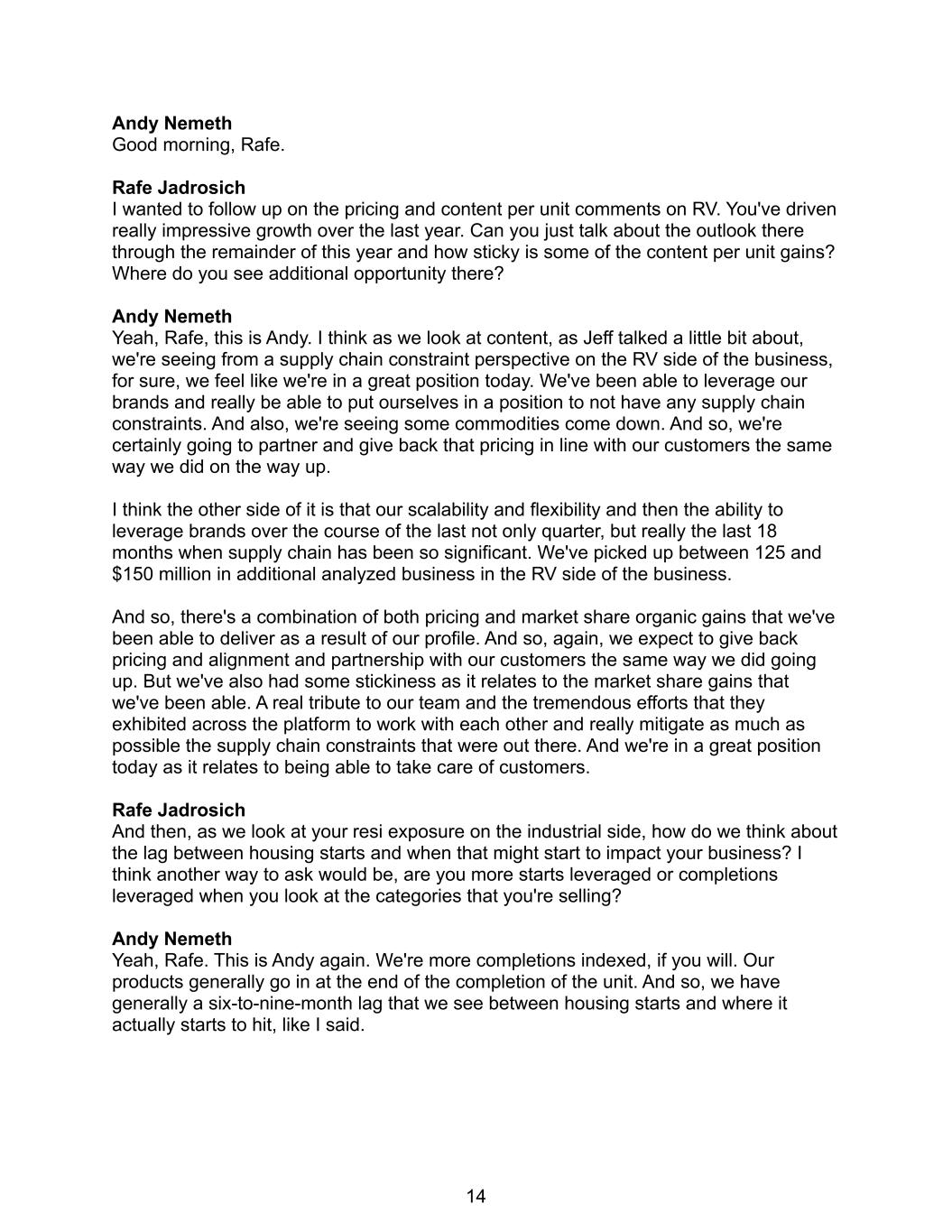
14 Andy Nemeth Good morning, Rafe. Rafe Jadrosich I wanted to follow up on the pricing and content per unit comments on RV. You've driven really impressive growth over the last year. Can you just talk about the outlook there through the remainder of this year and how sticky is some of the content per unit gains? Where do you see additional opportunity there? Andy Nemeth Yeah, Rafe, this is Andy. I think as we look at content, as Jeff talked a little bit about, we're seeing from a supply chain constraint perspective on the RV side of the business, for sure, we feel like we're in a great position today. We've been able to leverage our brands and really be able to put ourselves in a position to not have any supply chain constraints. And also, we're seeing some commodities come down. And so, we're certainly going to partner and give back that pricing in line with our customers the same way we did on the way up. I think the other side of it is that our scalability and flexibility and then the ability to leverage brands over the course of the last not only quarter, but really the last 18 months when supply chain has been so significant. We've picked up between 125 and $150 million in additional analyzed business in the RV side of the business. And so, there's a combination of both pricing and market share organic gains that we've been able to deliver as a result of our profile. And so, again, we expect to give back pricing and alignment and partnership with our customers the same way we did going up. But we've also had some stickiness as it relates to the market share gains that we've been able. A real tribute to our team and the tremendous efforts that they exhibited across the platform to work with each other and really mitigate as much as possible the supply chain constraints that were out there. And we're in a great position today as it relates to being able to take care of customers. Rafe Jadrosich And then, as we look at your resi exposure on the industrial side, how do we think about the lag between housing starts and when that might start to impact your business? I think another way to ask would be, are you more starts leveraged or completions leveraged when you look at the categories that you're selling? Andy Nemeth Yeah, Rafe. This is Andy again. We're more completions indexed, if you will. Our products generally go in at the end of the completion of the unit. And so, we have generally a six-to-nine-month lag that we see between housing starts and where it actually starts to hit, like I said.

15 The difference, though, is going to be on the multi-family mix change, and we look at that. And so, we do think there's some resilience there on multi-family that will help offset some of that. Rafe Jadrosich Got it. Thank you. And then, just on the M&A side, are you seeing, given the end markets have slowed down here and we're in a tougher macro and financing environment, have you seen multiples come down at all? And how are you handling your approach to M&A in this environment? Andy Nemeth Yeah, this is Andy again. We have seen multiples come down. We're also seeing activity right now, especially as we're looking at some volatility in the marketplace. And so, I think as Jake mentioned, from a liquidity perspective, from a leverage perspective, we're in an incredibly strong position to be able to take advantage of these opportunities as they come about. And so, we're excited about going into whatever this uncertainty is from a position of strength, really being able to evaluate our capital allocation and deploy capital strategically and appropriately. But from an acquisition pipeline perspective, we continue to cultivate acquisitions, both organically and have deal flow coming to us. So, we feel pretty good about where things are at. Multiples have definitely come down, and we're in a great position to execute. Rafe Jadrosich Great. Thank you. Operator Thank you. As a reminder, that's star one to be placed in the question queue. One moment, please, while we poll for questions. We have reached the end of our question-and-answer session. I'll turn the floor back over for any further or closing comments. Andy Nemeth I want to conclude our call today by recognizing the outstanding contributions of the Patrick team that make our achievements possible. I'm proud of what we have accomplished by adhering to our better together values and customer first philosophy. We will continue to strategically invest in our platform, automation, and innovation, driving scalability and positioning ourselves for strength with a diversified and resilient business model.
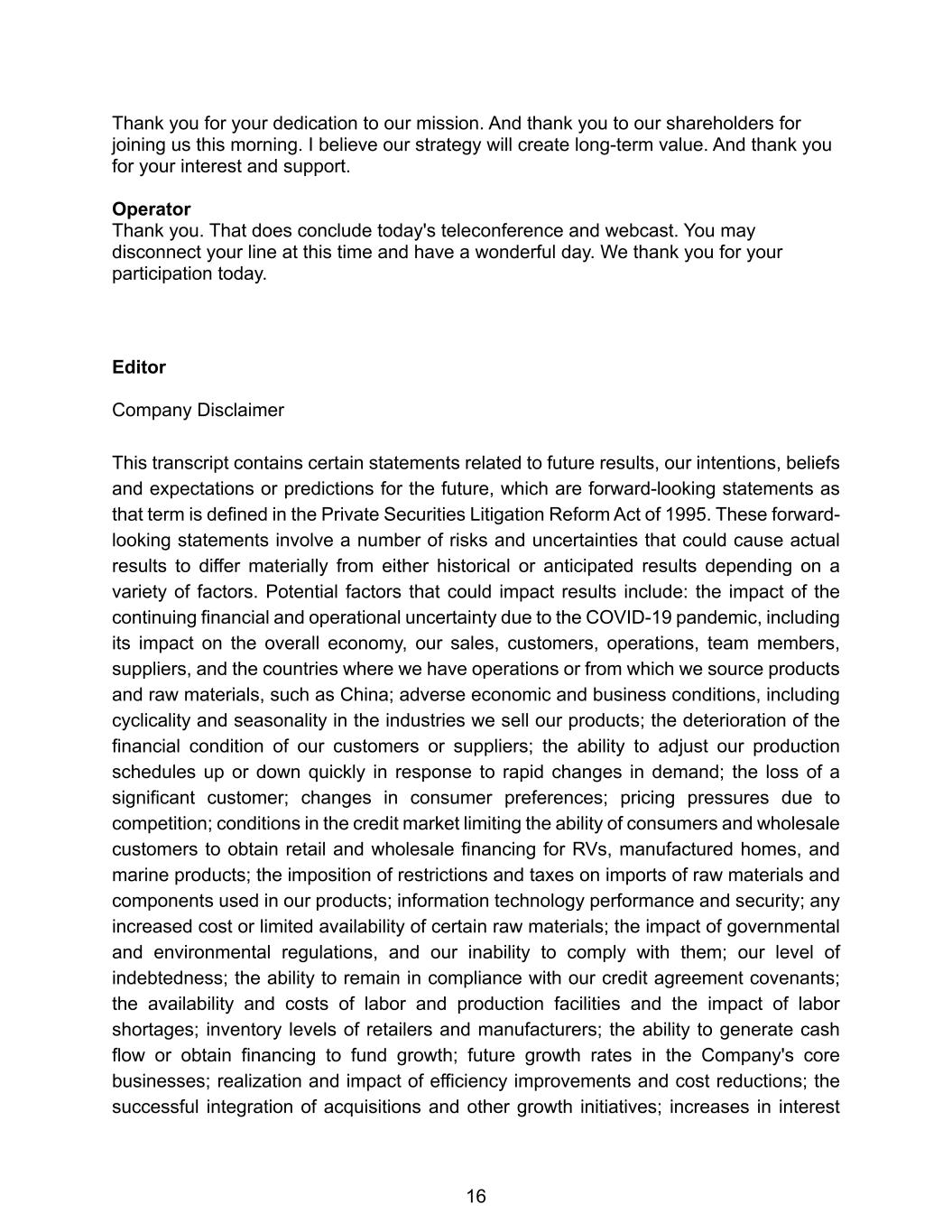
16 Thank you for your dedication to our mission. And thank you to our shareholders for joining us this morning. I believe our strategy will create long-term value. And thank you for your interest and support. Operator Thank you. That does conclude today's teleconference and webcast. You may disconnect your line at this time and have a wonderful day. We thank you for your participation today. Editor Company Disclaimer This transcript contains certain statements related to future results, our intentions, beliefs and expectations or predictions for the future, which are forward-looking statements as that term is defined in the Private Securities Litigation Reform Act of 1995. These forward- looking statements involve a number of risks and uncertainties that could cause actual results to differ materially from either historical or anticipated results depending on a variety of factors. Potential factors that could impact results include: the impact of the continuing financial and operational uncertainty due to the COVID-19 pandemic, including its impact on the overall economy, our sales, customers, operations, team members, suppliers, and the countries where we have operations or from which we source products and raw materials, such as China; adverse economic and business conditions, including cyclicality and seasonality in the industries we sell our products; the deterioration of the financial condition of our customers or suppliers; the ability to adjust our production schedules up or down quickly in response to rapid changes in demand; the loss of a significant customer; changes in consumer preferences; pricing pressures due to competition; conditions in the credit market limiting the ability of consumers and wholesale customers to obtain retail and wholesale financing for RVs, manufactured homes, and marine products; the imposition of restrictions and taxes on imports of raw materials and components used in our products; information technology performance and security; any increased cost or limited availability of certain raw materials; the impact of governmental and environmental regulations, and our inability to comply with them; our level of indebtedness; the ability to remain in compliance with our credit agreement covenants; the availability and costs of labor and production facilities and the impact of labor shortages; inventory levels of retailers and manufacturers; the ability to generate cash flow or obtain financing to fund growth; future growth rates in the Company's core businesses; realization and impact of efficiency improvements and cost reductions; the successful integration of acquisitions and other growth initiatives; increases in interest
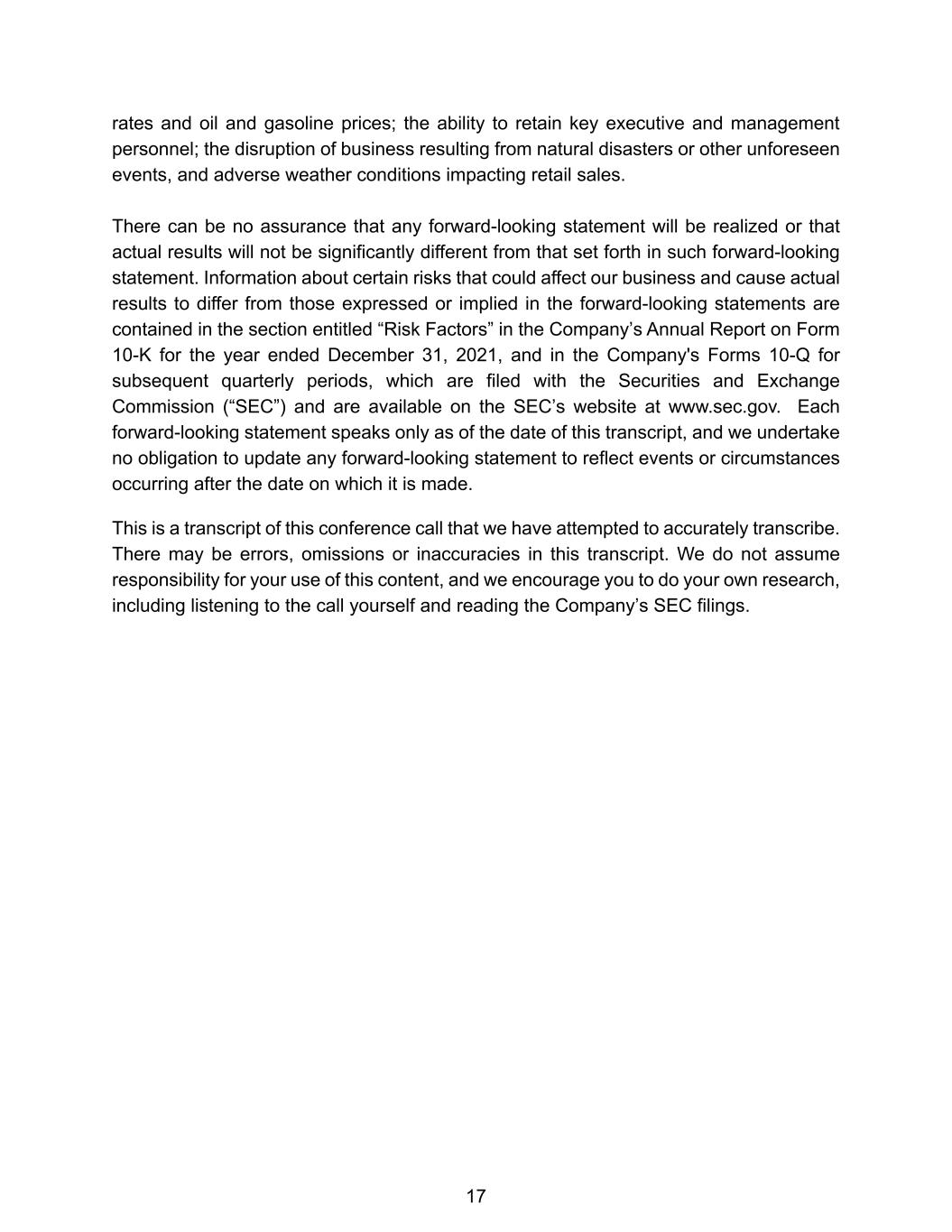
17 rates and oil and gasoline prices; the ability to retain key executive and management personnel; the disruption of business resulting from natural disasters or other unforeseen events, and adverse weather conditions impacting retail sales. There can be no assurance that any forward-looking statement will be realized or that actual results will not be significantly different from that set forth in such forward-looking statement. Information about certain risks that could affect our business and cause actual results to differ from those expressed or implied in the forward-looking statements are contained in the section entitled “Risk Factors” in the Company’s Annual Report on Form 10-K for the year ended December 31, 2021, and in the Company's Forms 10-Q for subsequent quarterly periods, which are filed with the Securities and Exchange Commission (“SEC”) and are available on the SEC’s website at www.sec.gov. Each forward-looking statement speaks only as of the date of this transcript, and we undertake no obligation to update any forward-looking statement to reflect events or circumstances occurring after the date on which it is made. This is a transcript of this conference call that we have attempted to accurately transcribe. There may be errors, omissions or inaccuracies in this transcript. We do not assume responsibility for your use of this content, and we encourage you to do your own research, including listening to the call yourself and reading the Company’s SEC filings.